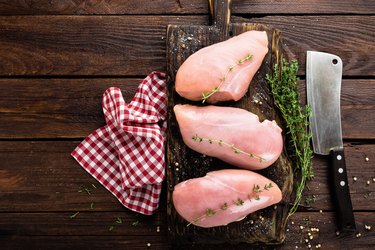
Keep splatters at bay — make baked chicken in foil. This versatile cooking method allows you to roast plain chicken, coat it with crumbs for a crispy crust, infuse it with flavor from seasonings, or smother it with your favorite sauce.
Wrapping chicken in foil seals in natural juices, keeping boneless, skinless chicken breasts moist and tender. By including vegetables in the foil, you can create a complete meal in a disposable roasting wrapper. Who doesn't like fewer dishes to wash?
Video of the Day
Video of the Day
Read more: General Nutritional Facts About Chicken
Things You'll Need
Aluminum foil
Cooking spray
Cooking oil or clarified butter
Seasonings
Sauce (optional)
Vegetables (optional)
Step 1: Prepare Your Oven and Foil
Set your oven to 350 degrees Fahrenheit. Tear off a sheet of heavy-duty aluminum foil large enough to surround a chicken breast one and a half times. If you are adding vegetables to your foil packet, tear off a slightly larger piece.
Spray the foil with cooking spray to prevent sticking, or use nonstick aluminum foil. Use one sheet of foil for each piece of chicken you are baking.
Step 2: Prepare Your Chicken
Trim excess fat and remaining bits of skin from the chicken if necessary, rinsing it if desired. Place one chicken breast in the center of each prepared foil sheet.
Read more: Which Are the Fatty Parts of a Chicken?
Tip
Slice the chicken breast across the grain about two-thirds of the way through the meat, spacing the cuts about three-quarters of an inch apart. Toss crumbled bleu or feta cheese with baby spinach leaves and spoon the mixture into the slits. Lightly season the chicken and wrap the foil around it to seal the packet before baking.
Step 3: Season Your Chicken
Rub the surface of the chicken with oil or clarified butter. Sprinkle the meat with your seasonings of choice. Options might include salt, pepper, onion or garlic powder; or herbs such as sage, rosemary, thyme, oregano or French tarragon.
Be aware that many seasonings are high in sodium. The American Heart Association recommends a daily sodium intake of no more than 2,300 milligrams. If you have high blood pressure or risk factors for heart disease, that recommendation drops to 1,500 milligrams.
Tip
Create a crispy crust by rubbing the uncooked chicken with oil and rolling it in crumbs or whole-wheat flour before placing it on the foil. Bake it without vegetables, opening the foil for about five minutes near the end of the cooking time to allow steam to escape and a crust to form.
Another option is to dip your uncooked chicken in your favorite sauce and then wrap it in foil, sealing the packet carefully to keep the sauce inside.
Step 4: Add Your Vegetables
Add prepared vegetables if desired. Julienne or thinly slice firm vegetables, such as potatoes or carrots. Tender vegetables, such as zucchini or shallots, can be cut thicker to help them hold their shape.
Other vegetables that don't require slicing may also be included. Asparagus, snow peas or cuts of yard-long beans are good candidates for foil packets. Place selected vegetables on the foil with the chicken.
Step 5: Create Your Foil Packet
Create a foil packet by bringing the side edges of the foil to meet above the food. With the edges together, fold the two layers of foil down until the fold is close to the food.
Press the fold flat against the food. Fold and crimp each end of the foil to seal the packet.
Step 6: Bake Your Foil Packets
Place the foil wrapped chicken in the oven on a baking sheet. Bake the chicken packets for about 30 minutes.
Open each packet to check for doneness. The chicken is done when it is no longer pink and the internal temperature of the thickest part of the breast is 165 degrees Fahrenheit on an instant-read thermometer — the minimum safe temperature for poultry, according to the USDA Food Safety and Inspection Service.
Rewrap the tin foil chicken if it is not done and return it to the oven to finish cooking. After baking is complete, discard the foil and enjoy!
Read more: How to Bake a Plain Chicken Breast
Warning
Wash your hands thoroughly with warm water and soap after handling raw chicken. Also sanitize the sink, counter and utensils to prevent cross-contamination from the raw chicken, as advised by the Centers for Disease Control and Prevention.
Was this article helpful?
150 Characters Max
0/150
Thank you for sharing!
Thank you for your feedback!